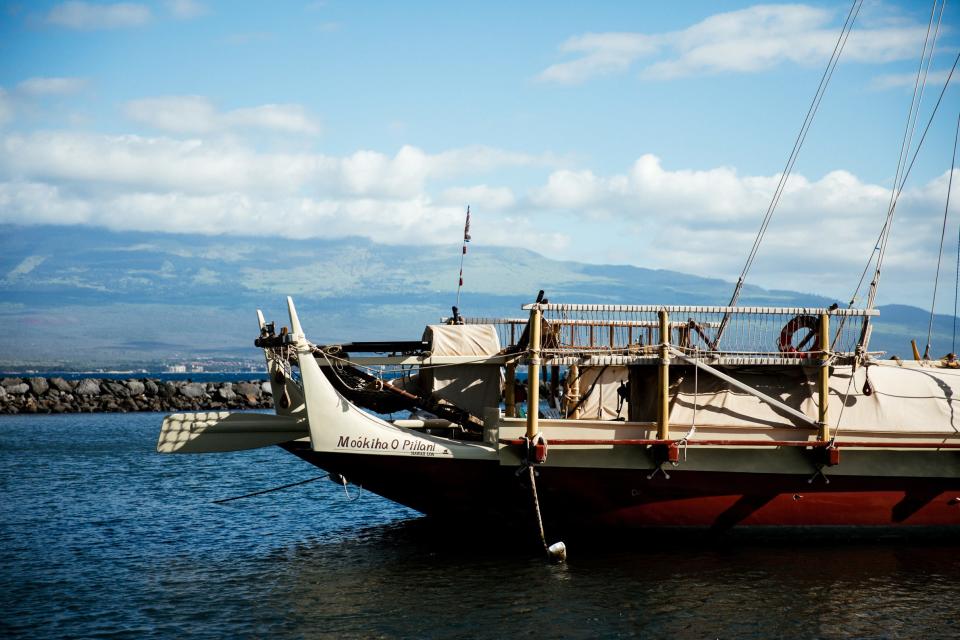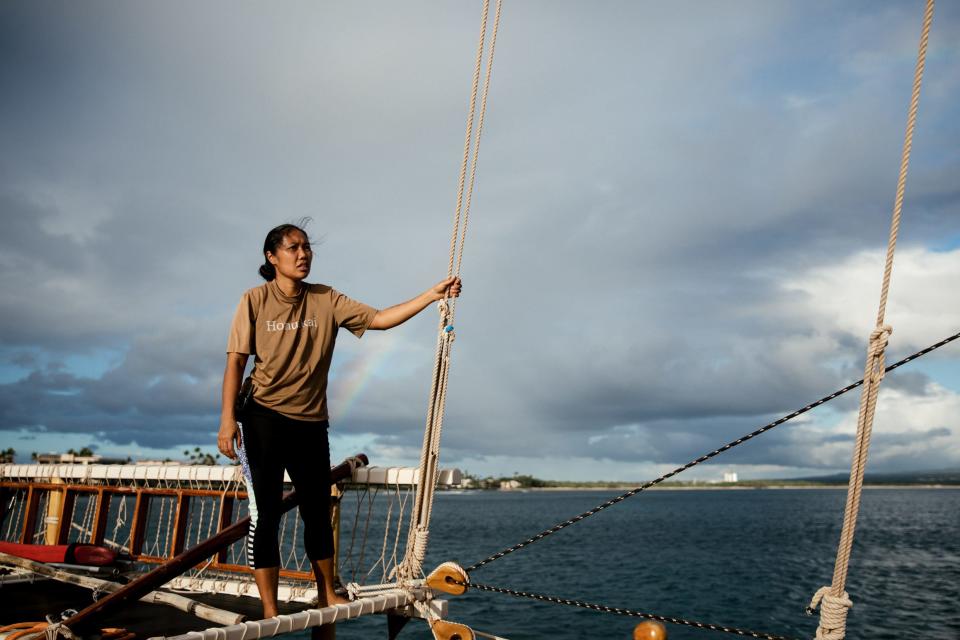Meet Kala Baybayan Tanaka, a Hawaiian navigator who helped shape Disney's 'Moana'
When regular people look up at the night sky, they might see the moon, the stars, or maybe even a planet. But Kala Baybayan Tanaka is not a regular person. When she looks up at the night sky, she sees a way – a path forward, both literally and figuratively.
As an apprentice navigator and Native Hawaiian voyager, Maui-born Tanaka taps into her heritage to observe nature – the stars above her, the wind against her skin, the flotsam and jetsam moving in the water, the birds soaring past – to sail across the ocean in a voyaging canoe, or wa'a, to other Pacific islands. She is also part of the growing number of women who are partaking in the once-male-only tradition.
"This was part of that technology and that knowledge our ancestors used to traverse the oceans. It wasn’t that the oceans separated us, but the oceans connected us," Tanaka said.
INCLUSION ON THE WAVES: Plus-size women surfers have a champion in Hawaii
DIGITAL NOMADS: Portugal among the top 5 safest, healthiest countries for female digital nomads
Predating compasses and clocks, Polynesian sailors navigated the open ocean using the natural world around them. It's similar to the way birds migrate south and return home, or people used the North Star to position themselves.
Navigators like Tanaka's family and others keep the ancient practice alive today, which is meaningful since there was a time when European settlers banned the Hawaiian language and suppressed Hawaiian practices like hula until a cultural resurgence in the 1970s.
Her late father, pwo (master) navigator Kalepa Baybayan, was one of the original crew members of the Hōkūleʻa, the first traditional voyaging canoe built in modern times as a milestone in reviving wayfinding. In 1976, the Hōkūleʻa made news when it sailed between Hawaii and Tahiti without modern-day navigational instruments, confirming the scientific validity of the ancient Polynesian art and science and amplifying cultural pride.
Although Tanaka grew up around the canoe, it wasn't until she was in college studying Hawaiian language and studies that Tanaka decided to join her father on a voyage. "(It was) an important time in my life, questioning who I was as a Hawaiian and my identity," she said.
She remembers feeling intimidated on her first voyage with her father, which launched from Oahu to Lahaina in 2006 and took less than 24 hours. Not only was she the only female onboard but the crew members spoke only in Hawaiian. Her anxiety melted away when they took off.
"My father was my foundation, my rock, and I knew I would be OK," she said. Her father taught her and the other students how to look at the ocean swells and use them to hold the course when steering. "When the stars came out, he was telling us their names and purpose," she said. "After that, I never stopped."
How do wayfinders navigate?
For a sense of what it's like to navigate without modern instruments, Tanaka said navigators will look at over 200 stars and note if they appear to be rising or setting. "You know that this is this star and the direction it represents," she said. "If you can do that, you can use it as a tool to orient."
She added, "They appear to move in a direction, and that's why observation (kilo) is very important." The navigator stands at the back of the canoe, feet wide to stay balanced and feel the rhythm of the ocean swaying beneath.

During the day, Tanaka uses the sun until it hits a certain height and then observes wind and ocean swells to hold direction. At night, depending on the visibility, she will navigate using the stars, moon, planets, wind and swells.
To navigate, she measures the wind and ocean swells against the stars to find the direction she's coming from. Once she knows that, she can use the stars as a tool to hold a direction and always understand her location.
"As we get closer to land, we are looking for certain species of land birds that fish in the ocean, stationary clouds where the sun does not seem to penetrate, even certain cloud formations and color can indicate there is land below it," she said.

On board the canoe for sometimes weeks at a time, the crew sleeps together in a line inside the canoe's hulls and eat what they catch from the sea. The navigator is often awake for many hours a day, making sure the canoe stays the course. Together, the crew braves the elements.
When she sails, Tanaka feels "very connected to my past and where I came from," she said. "I feel very connected to the sky above me and the ocean below me. I feel very connected to the crew and the canoe. We're a family, we're an ʻohana."
'It really tested me'
To Tanaka, one of the most special voyages will always be her last sail with her dad in 2017. The two sailed from Oahu to Tahiti aboard the Hikianalia, a sister canoe to the Hōkūleʻa, in which Tanaka was a first-time captain.
"I always reflect on that – the relationship as a father and daughter and a student and teacher," she said. Her father died about a year ago. She was "grateful" for the "rare" opportunity to sail with her father.
"At the same time, it was a huge learning experience and it really tested me," she added. "My father was the sail master in this voyage and this was my first long voyage captaining so I was nervous, but his mentorship in preparation for this and on the voyage certainly made this a success. It’s a huge responsibility."
After almost a decade of voyaging, Tanaka said she's in a space where she feels like she's still learning but feels a kuleana (responsibility) to teach the next generation and perpetuate the skills. "They're going to take it further, they're starting at an earlier age than I am," she said. "The majority of what you learn is when you're out there doing it."
Perpetuating the wayfinding culture
As an educator with Hui o Wa'a Kaulua, Maui's Voyaging Society, she takes kids as young as high schoolers out on the canoe for day sails with her voyaging society.
"In the beginning, it’s kinda tough on them. They are trying to figure things out and it is physically demanding," she said. "But, by the end, I see a change in them, in that they have a better understanding of what they are doing and what they need to do, I certainly see their confidence grow and that is a rewarding feeling for me."
Tanaka also educates guests at the Four Seasons Resort Maui's Hawaiian Star Stories events, where she shows people how to spot different stars with the naked eye and teaches them about wayfinding.
RETHINKING TOURISM: Here's how to respectfully visit Hawaii, have an authentic trip
In fact, Disney tapped Tanaka and other women from her voyaging society when researching for the 2016 hit movie "Moana," which is about an independent, daring young female character not so different from Tanaka. She helped consult Disney during a monthlong voyaging leg she was on from Virginia to New York City. Sailing during the day, the canoe stopped at each port going northward for community and school outreach engagements as well as protocol and ceremonies. The nights spent on the canoe were "a lot colder than Hawaii," Tanaka said, remembering bundling up with the right gear to stay warm.

Carrying on the values of her ancestors and fellow wayfinders, Tanaka prompts people to reflect on their relationship with the ocean.
"It's something that connects us and we need to take care of it," she said. "What I do will impact my cousins over there and what my cousins do over there will impact me here."
To her, the future seems bright. "I hope to see a new generation of voyagers. My hope is that we continue to sail and that canoes become more normalized," she said. "Our culture is living, it is a huge part of where we come from and where we're going in the future." At a time when climate change feels insurmountable and options need to be explored, she thinks tapping into indigenous knowledge "is so much more relevant now."
"We all collectively created our problems and we can all work to making it better, not only for us but for the sky, the ocean and all of that," she said.
This article originally appeared on USA TODAY: Meet the Native Hawaiian wayfinder who helped shape Disney's "Moana"

